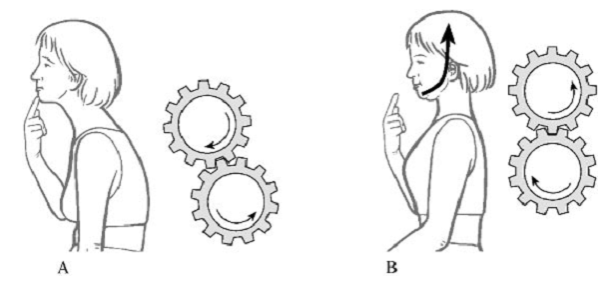Exercise 102: Stop Sitting
In Exercise 101, we talked about the dangers of excessive sitting (even if a regular exerciser). Today we will talk about some simple strategies to counter those effects.
1.Microbreaks
Microbreaks are simple, quick (10- 60 seconds) exercises that can be performed to break up periods of sitting. These are very important to aid the healing process post-injury but also to prevent chronic health problems related to increased sitting time.
The most important thing is to do them regularly (every 20- 30 minutes), so when sitting down at a desk set a timer (Tomato Timer), or if in front of the TV do them at each advert break. It doesn’t really matter what you do on a microbreak as long as you get moving, but below are some easy, safe and effective exercises to get you started.
Important: If any of these exercises cause pain or you do not feel it working in the target area, stop. Do another instead.
Overhead Reach

- Take a deep breath in, through your nose, and hold the breath as you raise your arms over head.
-
As you breathe out stretch up one arm and then the other whilst letting the spine move side to side, as if climbing a ladder. Repeat 2-3
times.
- Ideal for low back pain sufferers.
Lunge Stretch

- Place your front leg on a sturdy step or table. (Make sure you have a wall close by if balance is an issue).
-
Tilt your pelvis backwards but keeping your stomach relaxed, so your back flattens and you start to feel a slight pull in the front of your
rear thigh.
-
Gently push your hips forwards to increase the stretch. The movement should be through the hip not the back – DO NOT over-arch the low back.
- Hold for 30-60 sec each side.
- You should feel this stretch in the front of the hip/ thigh on the back leg, not the low back.
Glut Stretch

- Sit on a chair and cross one foot over the opposite knee (fig A).
- Lean forward from your hips (keeping your chest up) so that you feel a stretch in the back of your hips and buttocks (fig B).
- Hold the stretch for 30 seconds (making sure to breathe evenly throughout).
- You should feel a stretch at the back of the hip, not a pinch in the groin.
Hip Circles
- Stand tall, feet together, hands on hips.
- Gently rotate your hips clockwise and then anticlockwise.
- 5 circles in each direction.
- Can also perform with hands overhead.
Wall Slides

- Stand with your back against a door or wall with the back of your head against the wall and your chin tucked in.
-
Bring your feet forward away from the wall just far enough that you can keep the whole foot in contact with the floor throughout the
exercise (heels not lifting up).
- Place your arms above your head with your elbows at 90°.
- Keep your hands pinned against the wall as you squat slowly downwards.
- On the descent, actively breathe out and feel your abdominal muscles tighten
- You should feel a stretch/ pulling sensation either through the chest, the mid-back or both.
Cat Camel

- Start on all fours.
- Slowly move from position (A) to position (B) moving the whole spine including the neck.
- Only go as far as you can pain free.
- Perform 8-12 reps.
Chin tuck

- Stand tall.
- Slowly let your chin slide forward (A).
- Next, slide your head backwards tucking the chin, without flexing or extending the head or moving your back or chest (B).
- Hold for 2 seconds before relaxing.
- Repeat 10 times.
2. Sitting Alternatives
For those that work at a desk there may be no getting around having to sit for some period of time but there are variations and alternatives
that can help:
-
Change your set up: If you are using a chair change its set up throughout the day;
height/ angle of seat pan, angle of back rest etc. This will help you avoid continuously stressing the same areas of the body.
-
Sit-Stand desks: If you work at a desk I would highly recommend an adjustable
sit-stand desk. These allow you to move from a sitting to standing work position. But more isn’t always better and standing for too long,
particularly if not used to it, can also be harmful. Alternate between sitting and standing, and change standing postures frequently.
Anti-fatigue mats can also be useful when standing.
- Treadmill desk: Allows you to walk whilst working.
-
Swiss Ball/ Balance Disc: This will help you use different muscles as you sit.
-
Squatting – Long before chairs and seats we used to rest in a squat position (in fact
many cultures still do). This is a fantastic way to maintain good mobility and strength throughout the whole body. If you are really
dedicated you can try the Ido Portal 30 day squat challenge. (NB: This does require at certain level of foundational movement ability and
may not be appropriate for everybody, especially those in pain or with injury.)

3. Move More
Try and take every opportunity that you can to move.
- Walk instead of drive (or at least park a little further away).
- Take the stairs instead of the lift.
- Take ‘walking meetings’.
- And for more ideas take a look at this PDF form the World Health Organisation.
Doing a little everyday will add up in the long run.
What do you do to keep moving throughout the day? Leave a comment below…
*Figures reproduced from Liebenson. C., Journal of Bodywork and Movement Therapies







Leave a Comment